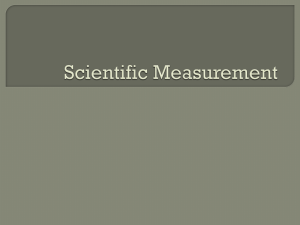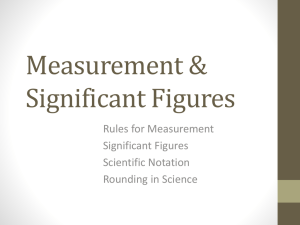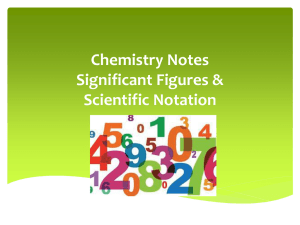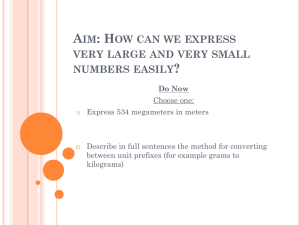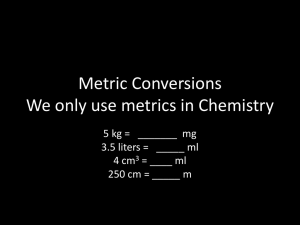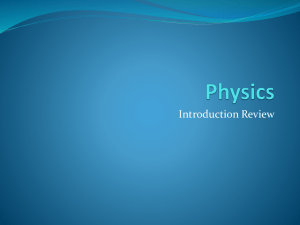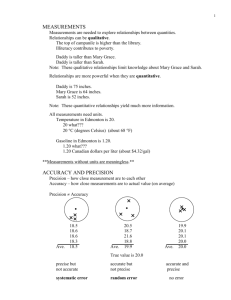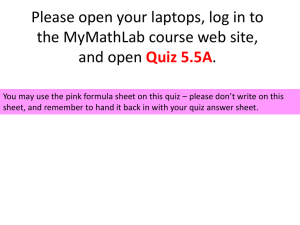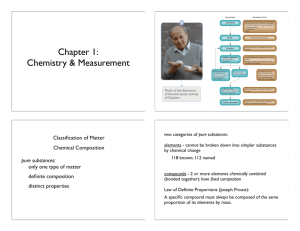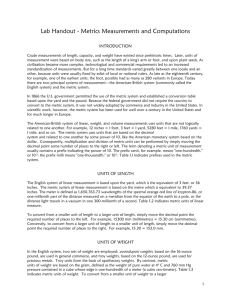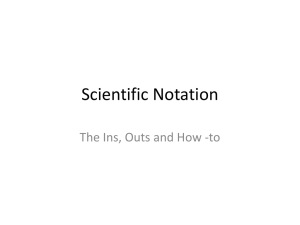Ch 5: Measurements and Calculations
advertisement
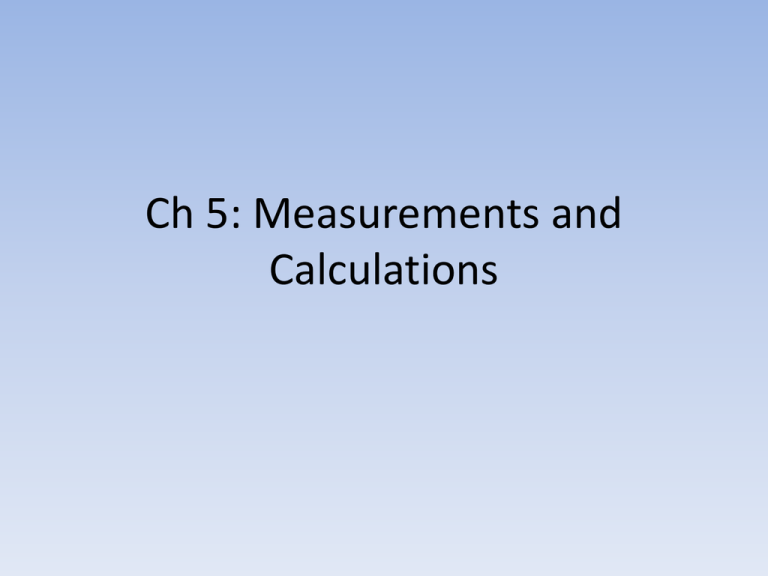
Ch 5: Measurements and Calculations I. Scientific Notation and Units A. Scientific Notation: A way to easily show lengthy numbers. 1. Thegrams Sun isof93,000,000 away if you travelled 5000 miles per hour 12 carbon hasmiles 602,200,000,000,000,000,000,000 atoms in it. n MIfhow x 10 where 1 < M < 10 many hours would take to reach sun? a pile of carbon weighsit 41 grams, howthe many carbon atoms are in the pile? How many days would it take to reach the sun? different to show a number / 10years = way n = decimals to move. HowA4.3 many would it take to reachand the sun? a) Move till number is between 1 and 10 x 10decimal = = 4.3 /10/10 b) Determine 4.3 /10/10/10 x 10 x 10 =the = exponent (n) – 4.3 Positive nx10 =this moved to the left What’s x 10the x 10rule = shows? time by 10toitthe moves the decimal to the left 1 spot – Every Negative ndivide –this moved right What’s theyou rule shows? Every time you multiply by 10 it moves the decimal to the right 1 spot. Scientific Notation Practice • Change the following to Scientific Notation 1. 2. 3. 4. 9314 0.08042 0.0000517 7,124,369,582 • Change the following to standard numbers. 1. 4.17 x 104 2. 6.19 x 10 -2 3. 3.001 x 10-5 4. 5.91 x 10 7 B. Units: Indicator of what scale is used for measuring. 1. International System of Measurement (SI) a. b. c. d. e. Mass = The quantity of matter in an object = Grams (g) Length = Meters (m) Time = Seconds (sec) Temperature = Kelvin (K) Volume = 3 dimensional space taken up = Liter (L) C. Use prefixes to make numbers usable (verbal multiplier) Converting Metric Prefixes. 1. Determine the difference between the exponent for each unit. 2. Move the decimal that many places. Base Unit -g -L -m • If going down the table, move right. • If going up the table move left. Convert The following 5.45kg g 6.19nm m 100 4.90 x 107 µL kL 1.34 x 10-5 ML L µ II. Uncertainty in Measurments A. All measurements have an estimated digit. 1. Determine the smallest digit that is indicated on the device, and estimate one digit farther. B. Significant Figures: The numbers that were actually recorded in a measurement. 1. Rules for counting Significant Figures: a. Nonzero’s are significant b. Final zero’s after the decimal are significant c. Zero’s that are between other significant figures are significant. How many significant figures are in each of the following numbers? 1) 2) 3) 4) 0.00240g 1.00240 1000L 1000.0L Pg 146 Example 5.3 a-d C. Exact Numbers: numbers determined by counting. 1. have unlimited significant digits. Pg 146 Practice Problem Exercise 5.3 a-c D. Significant Figures in Calculations: (How many digits should I keep in my answer?) 1. Addition or subtraction: The answer may hold as many decimal places as the number from the problem that has the least decimal places. (round to that place value) 12.11g + 18.0g + 1.013g = 31.123g 353.2mL + 17.89 mL= 371.09mL 183.062km – 14km = 169.062km 2. Multiplication or Division: The answer may hold as many significant figures as the number from the problem that has the least significant figures. (round to that number of significant figures. 2 Pg4.56 149 m Practice Exercise 5.5 a-c x 1.4mProblem = 6.384m 8.315g 298L = 0.0279027g/L Pg 150:/5-7 4.87m / 8.73g x 13m = 7.252 m2/g 5. How many sig. fig. should be in each result a) 2 b) 1 c) 2 d) 3 6. Results a) 5.4 b) 100 c) 5.0 x 107 d) 88500 7. Number of sig. figs in a measurement. a) 2 (example is 14) b) 3 (example is 3.14) c) 2 (example is 4.6) III. Problem Solving and Unit Conversions You need two dozen doughnuts for advisory groups. Dunkin Donuts sells doughnuts for A. Problem $0.50 each. How much willSolving: the doughnuts cost? 1. Where do we want to go? What is the problem asking for? 2. What do we know? List of facts. 3. How do we get there? What steps can we take to solve the problem. 4. Does it make sense? Evaluate if the answer is reasonable Algebra Review 1. 2. 3. 4. 𝟏 = 𝟏 5 = 5 1.456 1.456 𝑥 = 𝑥 = 5. What’s the rule? Anything divided by itself = 1 Algebra Review 1. 2. 3. 4. 5. 6. 5•1= 17 • 1 = 1.456 • 1 = 1,346,000.309534 • 1 = x• 1 = What’s the rule? Anything multiplied by 1 stays the same. Algebra Review 1. 2. 3. 4. 2𝑥 = 𝑥 4𝑥 = 2𝑥 6𝑥 2𝑦 • = 1 𝑥 3𝑦 45x • = 9𝑥 B. Converting Units of Measure: Changing the units of a measurement but keeping the value the same. 1. Equivalence Statement: Shows two different #’s that are thedoughnuts same value. (2.45cm = 1 in.) SeeDonuts pg 153 You need two dozen for advisory groups. Dunkin sells doughnuts for $0.50 each. 2. HowConversion much will theFactors: doughnutsAcost? (show unit two conversion) ratio thatusing relates units. a. They are made from the 2 parts of an equivalence statement. » b. 2.54𝑐𝑚 1𝑖𝑛. or 1𝑖𝑛 2.54𝑐𝑚 A conversion factor allows us to cancel out a unit and replace it with new unit. Practice Problem 5.6 pg 156 Use Use Table Table 5.7 to 5.7make to make the following the following conversion. conversion. Convert Convert 3.79kg 35.7qt to to L 2.37mi tolbs. m. 3. How to use a conversion factor to do a conversion a. b. c. d. e. Pg 170:2-4 Identify the equivalence statement(s) that will help with this problem. Write the number and unit given in the problem. Multiply by a conversion factor (fraction) where • The bottom has the unit you want to get rid of. (so it cancels out) • The top has the unit that you want to end up with. Do the appropriate math. Make sure you have the correct number of significant figures. (look at the original measurement to determine sig. figs.) Conversion Factors and metric Prefixes. 1 M__ = 106 __ 1 k__ 1 1 1 1 1 1 1 100 µ Convert 35mg to g Convert 7.38m to Mm Convert 41.9kL to dL = 1 d__ = 1 c__ = 1 m__ = 1 µ__ = 1 n__ = 103 __ 10-1 __ 10-2 __ 10-3 __ 10-6 __ 10-9 __ C. Temp. Conversions 1. Celsius Scale: Based on the freezing and boiling point of water Tf = 0 oC Tb = 100oC 2. Kelvin Scale: Base on absolute zero as the coldest temp. Tf = 273K Tb = 373K 3. Conversions: a. C K add 273 to the celcius temperature. b. K C subtract 273 from the kelvin temperature. Complete the following conversions -215 143oo Cto Ctoto K oo C 198K 199K C D. Density: The amount of matter present in a given volume of a substance. 1. Mass per unit of volume 2. The density of a type of material is always the same. (ie. The density of copper is 8.92g/mL) • D= 1. 𝑔 ( ) 𝑚𝐿 𝑚 𝑣 m = mass (g) D = Density, V = volume (mL or cm3 ) Use this equation to determine the density, mass, or volume of an object. Density Problems The density ofa apiece rock is 0.9980g/mL. metalof is 45.3g 1.113g/mL. IfThe a density block ofofstone hasof a mass and takes up a What Whatisisthe volume mass of ofwhat the a piece rock ifdensity? the metal volume with aismass 345mL? of 1.45kg? volume ofthe 100.4mL, is itsof
